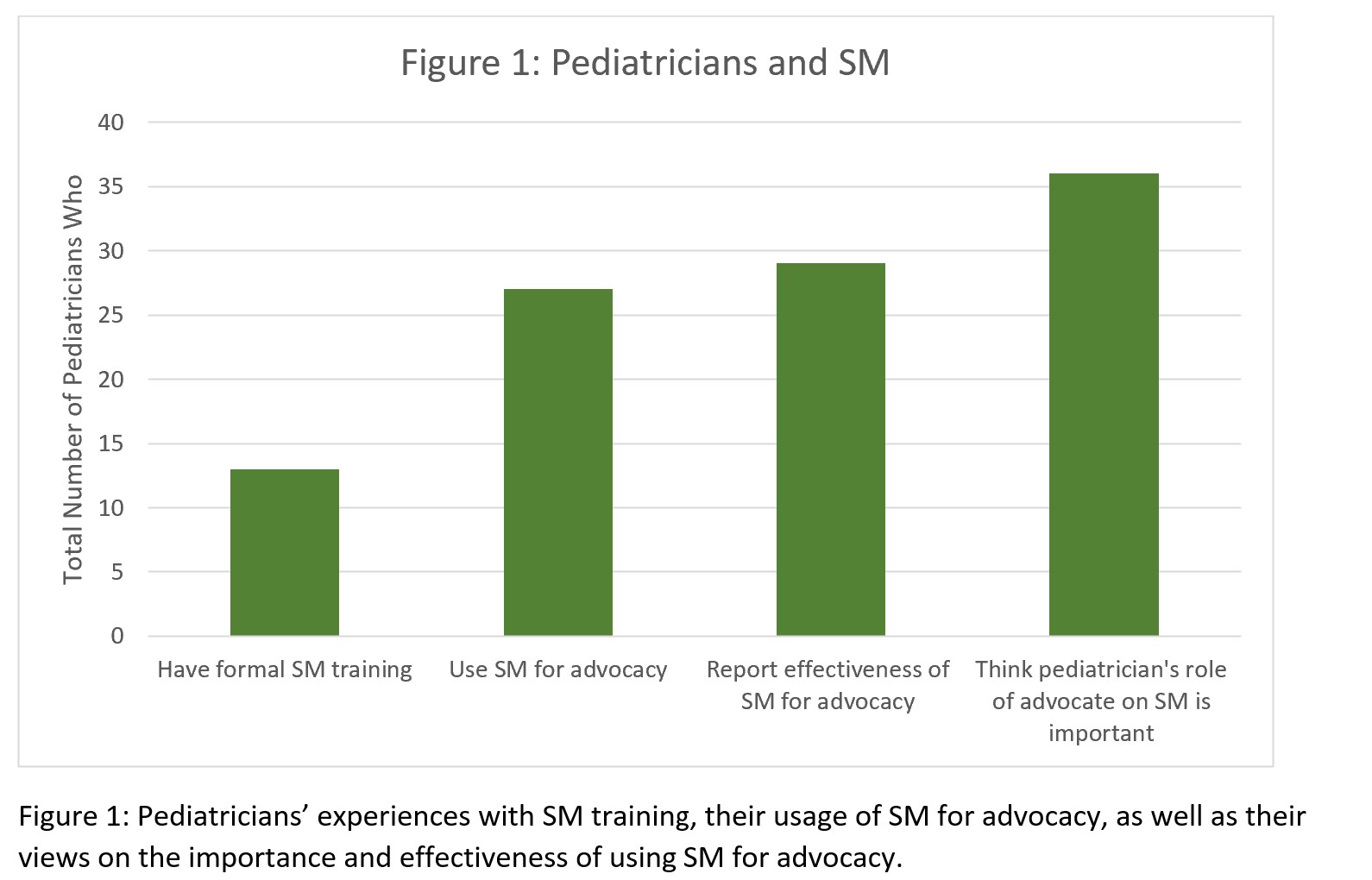Back
Social Media & Technology
Category: Abstract Submission
Social Media & Technology I
557 - To Post or Not to Post: Evaluating Pediatric Providers' Perspectives on Using Social Media for Advocacy
Saturday, April 23, 2022
3:30 PM – 6:00 PM US MT
Poster Number: 557
Publication Number: 557.245
Publication Number: 557.245
Elizabeth Herrin, McGovern Medical School at the University of Texas Health Science Center at Houston, Houston, TX, United States; Padma Swamy, Baylor College of Medicine, Houston, TX, United States; Sandra McKay, McGovern Medical School at the University of Texas Health Science Center at Houston, Missouri City, TX, United States

Padma Swamy, MD, MPH (she/her/hers)
Assistant Professor of Pediatrics
Children's National Health System
Washington, District of Columbia, United States
Presenting Author(s)
Background: Social media (SM) has facilitated connection of individuals from all walks of life. Many physicians, take part in SM for a wide variety of purposes, including but not limited to, professional outreach, advocacy, and personal use.
Objective: The purpose of the study is to describe Texas pediatric providers’ perspectives on using SM for advocacy.
Design/Methods: A cross-sectional study was conducted utilizing a survey. The anonymous survey consisted of demographics, current SM use, and SM for advocacy use. In addition, free-response questions were utilized to assess pediatric providers’ perceptions on SM advocacy. IRB approval was obtained from Baylor College of Medicine and UT Houston Health Sciences Center. The survey was then disseminated through the Texas Pediatric Society listserv from September 2021- October 2021. Data analysis consisted of descriptive statistics reported as means, medians, and frequencies.
Results: Fifty-one persons participated in this study, and a majority of participants were female (n=33/51, 64.7%), physicians in practice (n=50, 98.0%) and between the ages of 40-49 years old (n=16/51, 31.4%). Thirteen of the 51 participants (25.5%) reported having formal SM training. Twenty-seven participants (n=27/51, 52.9%) reported using SM for advocacy. A majority of pediatricians (n=29/51, 56.9%) reported that SM for advocacy was effective/very effective. Furthermore, participants reported that pediatricians have an important/very important role in child health advocacy (n=36/51, 70.6%). (See Figure 1).
Participants also reported several barriers to SM advocacy use. This included time limitations, fear of saying the wrong thing, cyber bullying, potential impacts on their employment, and perceived inability to reach the target audience. Some participants had no interest in utilizing SM at all, while others had been discouraged due to bad experiences and misinformation. (See Figure 2).Conclusion(s): Pediatricians reported that SM is effective for advocacy and a majority of participants utilize SM for advocacy. Yet, only 25% underwent formal SM training. Barriers cited by participants may have been due to fear of retaliation from those who disagree with their positions or perceived personal limitations, including inability to reach a target audience or fear of losing their jobs over taking a stance online. Receiving training on SM use, may address some barriers. Limitations of this study included a small sample size and response rate. Future directions include utilizing qualitative methodology to explore pediatricians’ perspectives on SM use.
Figure 1: Pediatricans and SM Pediatricians’ experiences with SM training, their usage of SM for advocacy, as well as their views on the importance and effectiveness of using SM for advocacy.
Pediatricians’ experiences with SM training, their usage of SM for advocacy, as well as their views on the importance and effectiveness of using SM for advocacy.
Figure 2: Pediatrician's Reported Barriers to SM Use for Advocacy.jpg)
Objective: The purpose of the study is to describe Texas pediatric providers’ perspectives on using SM for advocacy.
Design/Methods: A cross-sectional study was conducted utilizing a survey. The anonymous survey consisted of demographics, current SM use, and SM for advocacy use. In addition, free-response questions were utilized to assess pediatric providers’ perceptions on SM advocacy. IRB approval was obtained from Baylor College of Medicine and UT Houston Health Sciences Center. The survey was then disseminated through the Texas Pediatric Society listserv from September 2021- October 2021. Data analysis consisted of descriptive statistics reported as means, medians, and frequencies.
Results: Fifty-one persons participated in this study, and a majority of participants were female (n=33/51, 64.7%), physicians in practice (n=50, 98.0%) and between the ages of 40-49 years old (n=16/51, 31.4%). Thirteen of the 51 participants (25.5%) reported having formal SM training. Twenty-seven participants (n=27/51, 52.9%) reported using SM for advocacy. A majority of pediatricians (n=29/51, 56.9%) reported that SM for advocacy was effective/very effective. Furthermore, participants reported that pediatricians have an important/very important role in child health advocacy (n=36/51, 70.6%). (See Figure 1).
Participants also reported several barriers to SM advocacy use. This included time limitations, fear of saying the wrong thing, cyber bullying, potential impacts on their employment, and perceived inability to reach the target audience. Some participants had no interest in utilizing SM at all, while others had been discouraged due to bad experiences and misinformation. (See Figure 2).Conclusion(s): Pediatricians reported that SM is effective for advocacy and a majority of participants utilize SM for advocacy. Yet, only 25% underwent formal SM training. Barriers cited by participants may have been due to fear of retaliation from those who disagree with their positions or perceived personal limitations, including inability to reach a target audience or fear of losing their jobs over taking a stance online. Receiving training on SM use, may address some barriers. Limitations of this study included a small sample size and response rate. Future directions include utilizing qualitative methodology to explore pediatricians’ perspectives on SM use.
Figure 1: Pediatricans and SM
 Pediatricians’ experiences with SM training, their usage of SM for advocacy, as well as their views on the importance and effectiveness of using SM for advocacy.
Pediatricians’ experiences with SM training, their usage of SM for advocacy, as well as their views on the importance and effectiveness of using SM for advocacy.Figure 2: Pediatrician's Reported Barriers to SM Use for Advocacy
.jpg)
